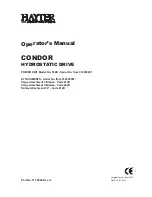
PowerSpout
TRG installation 2018
Last revised July 2018
© 2018 EcoInnovation Ltd (NZ)
Page 43
2.4.9.
Making the most of your pressure gauge
Your pressure gauge is essential in locating possible
problems. In most cases they are pretty accurate. To allow
for changes in temperature you should equalise the case
pressure by pushing the rubber bung aside with a thumbnail
to allow air in or out. If the bung is at the top of the gauge
then you can snip off the nipple in the bung to allow it to
breathe all the time. If your pressure reading is inexplicable
then you should try a new gauge for comparison, as no
gauge is infallible.
Check the static pressure with valves closed. If this is less than the predicted value for the
site then either the surveyed head (height difference) is incorrect, or there is air in the pipe.
Check also for significant leaks that might cause head loss due to their flow in the pipe.
Check that the pipe is full. (Overflow is visible at the intake; filter unobstructed, any high
spots in the pipe are clear of air pockets).
If the static pressure is higher than predicted then you need to be prepared for higher power
than expected or you need to reduce the size of your jets. The turbine will be running a bit
faster so there will be more voltage and you may need to add washers behind the magnet
rotor to compensate for this higher rpm and obtain the ideal output voltage.
Check the dynamic pressure with valve(s) open and compare with static pressure to obtain
pipe "efficiency". This should match your calculated efficiency.
If dynamic pressure is higher than expected whereas power (Watts) is low then you probably
have blocked jet(s). If dynamic pressure is lower then check for air in the pipe or leaks.
Another reason for lower dynamic pressure (inefficient pipe) is using too small internal
diameter. Check that the diameter inside the pipe matches the design calculation.
2.4.10. Turbine case flooding
On low head hydro sites, turbines are more exposed to flooding risk. TRG turbines (up to
120 VDC) can handle submersion on rare occasions.
Immediately following a submersion of the turbine you must:
Remove the magnetic rotor and clean off any magnetic grit carried by the water.
Regrease the bearings and run the turbine so that internal generator heat will dry it
out.
Damage caused by water submersion is not covered under warranty.



































